Let me start by saying: Rōki Sasaki is one of the most talented young pitchers on the planet.
I say that having watched each of his NPB starts from 2022, 2023, and 2024.
He started to turn heads as a high school pitcher in Japan. On April 10, 2022 he threw a perfect game against the Orix Buffaloes in which he struck out 19 batters, including 13 in a row. I wrote about his perfect game later that summer. He followed up perfection with another eight innings a week later, capping off possibly the greatest two-game stretch in major professional baseball. Sasaki has mesmerizing talent and has continued to put up gaudy stats in NPB.
Sasaki’s Recent Seasons (2022-2024)
| Season | IP | ERA | Strikeouts | Walks | K%-BB% |
| 2022 | 129 1/3 | 2.02 | 173 | 23 | 31% |
| 2023 | 91 | 1.78 | 135 | 17 | 34% |
| 2024 | 111 | 2.35 | 129 | 32 | 22% |
The Lotte Marines announced they would post the ace, even though he does not meet the current Japanese posting system requirements, as he is under 25. His contract will be restricted by international bonus pool money, limiting how much he can sign for as an international “amateur.” This opens his posting to every MLB team, many of which will surely pursue the young pitcher.
What makes him so special?
Sasaki’s arsenal includes a high-velocity, two-plane fastball, and a devastating splitter, both of which have tormented NPB hitters for years. He’s recently increased the use of his slider, turning it into a reliable weapon against both righties and lefties.
Sasaki is a control-over-command pitcher, but when he’s dialed in he can spot his fastball on the edges of the zone. Here are some well-located fastballs from Sasaki’s 2024 playoff start.
His splitter location is exceptional when it needs to be. Look at these heat maps from this NPB Pitch Profiler that show Sasaki’s command of the pitch.
vs Left-handed batters
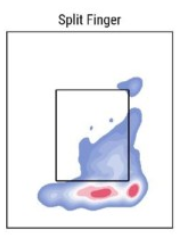
vs Right-handed batters
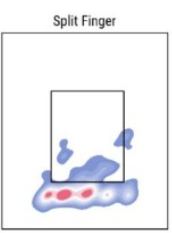
With a 56.5% whiff rate in 2024, Sasaki’s splitter is among the best in baseball. His ability to induce swings and misses, especially when the pitch darts below the strike zone, has made it a devastating strikeout pitch.
A mechanical tweak in 2024?
I wrote up a detailed breakdown of Sasaki’s mechanics in my last report on him and still think it captures a lot of what he does as a mover on the mound. However, in 2024 Sasaki added over 6 inches of extension to his delivery.
2022
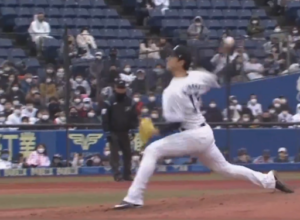
2024
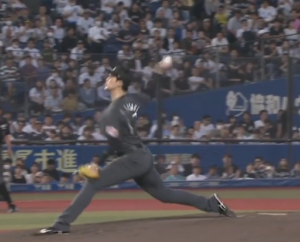
The increase in stride length down the mound is noticeable. As noted by Lance Brozdowski in his breakdown, Sasaki’s extension increased but his release height stayed almost identical at 6 feet. As Lance suggests, he might have kicked up his arm angle just a tiny bit which is not as clearcut on video but can be seen. There’s possibly a slight overextension in his stride that played a role in his downtick in velocity.
There’s a sweet spot in terms of mechanics for Sasaki, and an MLB team will try to find the bullseye. They’ll be trying to unlock more of his 2023 pitch shapes while also balancing injury risk and efficient throwing.
It’s important to note that the big question mark surrounding Sasaki is his health as he has battled various injuries throughout the last three seasons, including an oblique injury and shoulder fatigue.
Pitch Usage (2022-2024):
| Pitch | 2022 | 2023 | 2024 |
| Fastball | 56% | 50% | 46% |
| Splitter | 34% | 35% | 28% |
| Slider | 5% | 13% | 26% |
| Curveball | 5% | – | – |
Average Pitch Velocity (MPH):
| Pitch | 2022 | 2023 | 2024 |
| Fastball | 98.3 | 98.9 | 96.9 |
| Splitter | 89.1 | 89.5 | 88.2 |
| Slider | 87.7 | 87.5 | 83.6 |
| Curveball | 79.6 | 79.5 | 76 |
Against Right-Handed Batters (RHB)
| Pitch | 2022 | 2023 | 2024 |
| Fastball | 54% | 46% | 40% |
| Splitter | 29% | 27% | 21% |
| Slider | 12% | 26% | 39% |
| Curveball | 5% |
Against Left-Handed Batters (LHB)
| Pitch | 2022 | 2023 | 2024 |
| Fastball | 57% | 53% | 50% |
| Splitter | 36% | 41% | 33% |
| Slider | 1% | 4% | 18% |
| Curveball | 5% | – | – |
The Arsenal (2024 usage and Average Velocity)
Pitch Grades (20-80 Scale):
Fastball: currently a 70, was an 80 in 2023
Splitter: Currently an 80
Slider: Currently 55, could rise to 60
Breaking down the pitches:
Fastball 46%, 97 mph
CSW% 26%,
Strike% 71%
Sasaki’s drop in fastball velo has been a topic of conversation for most of the year. In May I speculated that Sasaki was more or less gas pedaling through starts. In other words, easing his way through starts because he was trying to pitch deep into games for the Marines. He was backing off at that point and then would run his fastball up to the upper 90s or triple digits.
Most notably May 10 in a start vs Nippon-Ham Sasaki produced one of the most disappointing starts of his NPB career, 5 2/3 innings and 5 earned runs. His next start would come seven days later. Against the same Fighters team, he threw his fastest average fastball velocity of the season, averaging 98.4 MPH.
Sasaki looked like his old self again until he dealt with a couple of injuries that sidelined him for two starts to begin June. Then he suffered another injury that cost him almost two more months. He was up and down with his velocity throughout the season but there were points where he was averaging 98 mph in some starts.
While having a dip in velocity, Sasaki also lost some movement both horizontally and vertically. He averaged around 16 inches of vertical movement on his fastball rather than the 18 inches he was averaging in 2024.
His fastball was still good in 2024. It just was not the unicorn-type pitch it had been the previous season. The whiff rate dropped from 24% in 2023 to 13% in 2024. The pitch in this new shape failed to miss as many bats in the zone.
Now as I have pointed out before, NPB hitters would sit on Sasaki’s fastball and try to foul off the pitch or shoot it the other way for minimal contact but try to get a base hit. There’s a decent chunk of emergency hack foul balls and swings that are late on his heater.
He allowed an OPS against of .740 on his fastball in 2024 compared to a .595 OPS against it the season prior. A lot of these hits were singles the other way or weaker contact singles blooped into the outfield.
Not many hitters in NPB squared up Sasaki’s fastball at any point in his career. He’s allowed a total of 6 home runs with it in the last three seasons, and just 2 all last season. Even with the dead balls in Japan, that’s impressive. Compare that to the 26 homers surrendered on fastballs by Shota Imanaga in his last two seasons in Japan.
You can see how good Sasaki’s four-seam is at limiting hard contact. In 2024, Sasaki was less sporadic with his four-seam command. He’s a pitcher who tries to cut the plate in half and work one side or the other with more control than command. However, he will still miss in the middle occasionally, which might lead to more damage on this pitch in MLB outside of normal changes in conditions between the two leagues.
Sasaki was more middle-third vertically than the upper part of the zone with his fastball this season.
This could explain why he also gave up more contact and had fewer whiffs to go along with the shape change. He was either choosing to be more efficient as a pitcher or the shape change just didn’t carry his pitches routinely to the upper third of the zone as it had in the past.
One thing that is likely to change as Sasaki comes stateside is the use of his four-seam at the top part of the zone. In the image below, which shows the heights were the catcher target was set for his pitches last season, the black squares are fastballs. Sasaki’s catcher rarely sets up high. Almost all of those dots are plotted in an area close to where the batter’s knees were.
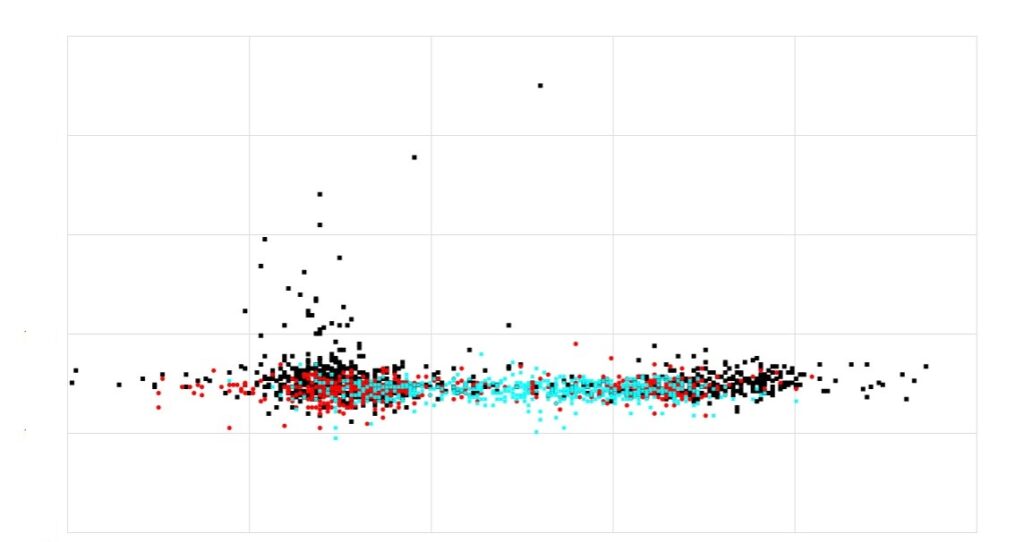
The catcher’s mitt is towards the bottom and shades to both corners. This isn’t to say he doesn’t target the catcher’s mask at times but there’s not a concerted effort to throw high fastballs. Even with his two-plane shape, an MLB team will want a higher percentage of top-shelf fastballs especially if he can harness more of the fastball shape he had at the WBC and during the 2023 season.
Sasaki’s fastball induces a lot of ground balls because of its horizontal movement. He had a 52% ground ball rate on his four-seam last season. Sasaki can keep the ball out of the air, which is always positive, and while there might be a slight uptick in home run production, don’t expect too much unless he starts to miss more in the middle of the plate. This means his command worsens, and his one big miss command-wise is usually high and arm side, with his fastball rather than yanking or pulling it.
Whichever MLB team gets Sasaki will want to try and bottle the magic of his 2023 fastball shape but it’s still a double-plus pitch in its current state.
Splitter 28%, 88 mph
CSW% 35%
Strike% 53%
Sasaki’s splitter is an oddity compared to other splitters. It’s the best splitter I’ve ever seen on video. It is a buzzsaw that knifes through the bottom of the zone and darts below it at the last possible second. As previously mentioned, his whiff rates on the pitch are astronomical. The way he throws the pitch and how it moves plays into its brilliance.
Sasaki throws the pitch with gyro spin but also can create a knuckling appearance on it. Sasaki can almost cut and fade the pitch based on handedness, as I noted previously.
In what I have decided is intentional to some extent, Sasaki will cut the splitter to his glove side away from right-handed batters, and pronate more to fade it away from lefties. He does this often enough to almost have a feel for his finger pressure on the pitch, though I can’t confirm this. The pitchability he displays with this specific pitch makes him unique in baseball, and his consistency with it is just as impressive.
What truly intrigues me is that in 2022 he was throwing his splitter with a different orientation and grip.
2022
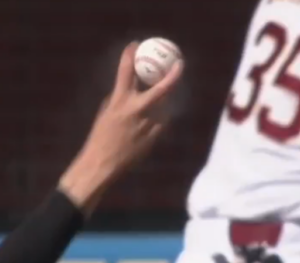
2024
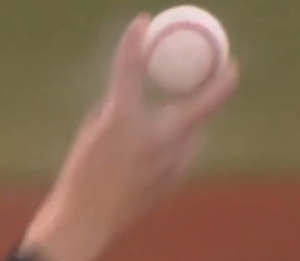
He now splits across the horseshoe with his fingers more down on the ball and has the pitch slip out of his hand, creating a knuckling or tumble effect while still maintaining hard velocity.
He still cuts and fades the pitch from time to time possibly by using different finger pressure. He’s opted for this type of movement that is closer to (0,0) on a pitch plot and more gyro.
Sasaki pairs his fastball with his splitter exceptionally well. It’s a wicked offering with almost magic-like qualities as it performs a disappearing act below the zone. Sasaki does have a knack for stealing strikes with it in the zone but does occasionally give up hits on hanging splitters that catch way too much of the plate, though that happens more to lefties than righties.
His ground ball rate on the pitch was near 71% the last two seasons but this past season it dipped to a still-impressive 57%, which bares out the greater number of line drives and fly balls on the pitch when it’s up in the zone. Sasaki’s splitter is one of the best pitches in all of baseball and will likely continue to be that.
One last note on the splitter is that Sasaki loves to use the rosin bag provided in NPB games and with no pitch clock he routinely goes to the bag, almost as if it’s part of his routine. He’ll be throwing with a different ball in MLB and it will be fun to see what grip he goes with and how he navigates using the rosin bag behind the mound within the confines of the pitch clock.
Slider 26%, 84 mph
CSW% 39%
STRIKE% 62%
A pitch that took a massive leap forward is Sasaki’s slider. He’s been workshopping the pitch for some time now, even having fellow countryman Yu Darvish help him during the World Baseball Classic. Love this video below:
<#Sasaki’s slider has become different, sharper & dominant
after receiving coaching from #Darvish !! It has improved
in vertical movement. pic.twitter.com/S4HTnB5I8s
— Joseph Kim (@blackwings2011) November 13, 2024
He upped the usage of the pitch considerably and in certain starts would throw his slider more than his fastball. It’s not yet a polished gem like his splitter but he would turn to the pitch against right-handed batters early in counts and then put away both left-handed batters and right-handed batters with his splitter.
Against RHBs, he tries to hit the opposite corner with the pitch, and while he will have it back up arm side, he is still working through the kinks with it. But his confidence in the pitch has blossomed.
While facing LHBs, he can drop backdoor sliders in the zone, especially early in counts as a first-pitch strike-stealer. The table below illustrates that he upped his first pitch slider usage from 13% in 2023 to 40% in 2024, which was most likely to combat hitters sitting on first-pitch fastballs. The fact he could zone the pitch also helped as the season pressed on.
2024 Count Usage
| Pitch | 1st Pitch Usage | 2-Strike Usage |
| Fastball | 46% | 34% |
| Splitter | 14% | 48% |
| Slider | 40% | 18% |
The slider is good and even flashes plus. He throws two slider shapes at times. I think it’s mostly manipulation of a slower one with more drop and the other is a true gyro one. But there’s some inconsistency there.
The more vertical one used to go backdoor mainly to left-handed batters but he also uses the vertical shape to both sides as well dropping it below the zone. Japanese pitchers will talk about varying shapes a lot more than most. I think a pitcher like Imanaga also has a wider variance on his slider, though he gets more sweeper movement than a pitcher like Sasaki.
Harder Slider:
Slower Slider:
Overall, the pitch is good and flashes plus at times, but the inconsistency in shape, whether intentional or not, is something an MLB team might look to refine. Based on pure spin rate numbers he lacks some ability to spin the baseball. It’s hard to be amazing at everything, but he does have a slider that has turned into a weapon that hitters must respect.
His growth on this particular pitch alone signals a chance to at least mold some fashion of a plus third pitch which would be outstanding for a guy who already obliterates hitters with his other two pitches.
He could opt for a harder slider like he had in the past, increasing the whiff rate on it. He’s most likely chasing more movement rather than velocity since he already sat around the velo of his splitter with his previous iteration of the pitch.
Sasaki might believe this new slider helped him stay in the zone more while having the manipulation factor to get more whiffs below the zone. The harder slider is likely better just from a pure pitch standpoint but comfortability in throwing it should play a massive part as well.
What about another pitch?
Well as seen in the above tables Sasaki in 2022 featured a curve that he threw about 5% percent of the time that was used sparingly along with his slider, which was also around 5%. He has thrown just three curveballs in the last two seasons, all but phasing the pitch out of his arsenal. He could bring it back though.
His slider at times would get more in the curve territory though. But it did not look exactly like his previous offering in 2022. Again, that’s going back to his manipulation of the slider.
An MLB team will likely experiment with a hard arm-side pitch, probably a sinker, although his two-plane fastball creates grounders already. It might not be worth a real development unless he struggles with right-handed batters.
Other options include upping velocity on his slider or maybe adding a cutter in the low-to-mid 90s, which could be fun! He could add a harder glove-side pitch to pair with his current slider if there’s not a complete rework of that pitch. He could have-in theory- a cutter and slider to use against right-handed batters although I expect the splitter to uptick in usage anyway.
There’s clay to mold here and while Sasaki can be dominant with just his splitter and fastball, he knows how valuable more pitches are to him as a pitcher. He’s likely going to add at least one more pitch, if not two, for right-handed batters.
MLB Projection and Future
You can count on one hand how many pitchers have as much talent as Sasaki. He has a high-velocity fastball with a nightmare fuel splitter. Add in a possible plus third pitch and he’s got all the tools to succeed.
His NPB career did not end in any major award wins and there was frustration with his health. He dazzled in his brief stint in NPB though, and like a shooting star streaking across the sky, his time there was too brief.
Sasaki’s ceiling is as high as any pitcher and while he’s not a finished product he has true ace potential and the chance to be one of the best pitchers in baseball. He’s one of the best pitching talents of my lifetime.


